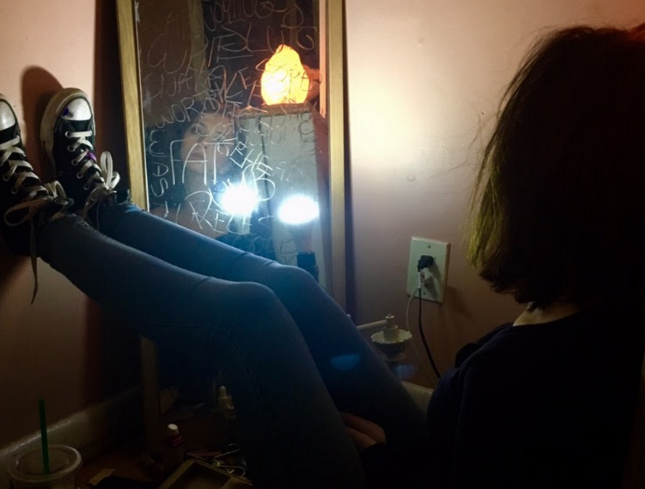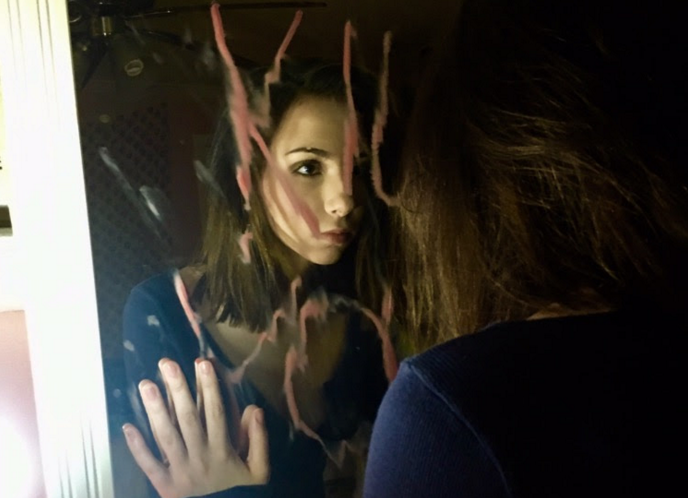Dying to be thin
Photo Credit: Julia Blando
When people look in the mirror, sometimes they see more than just a reflection.
April 25, 2017
*All names have been changed to protect the identities of those involved.
Merriam-Webster defines beauty as “the quality or aggregate of qualities in a person or thing that gives pleasure to the senses or pleasurably exalts the mind or spirit.”
Not once does beauty’s official definition refer to race, religion, weight, money, or any other specifics about human features. Not once does it say that one has to be skinny, with blonde hair and blue eyes to be considered beautiful. But the truth is, anything or anyone can fit into the definition of “beauty,” as there are no real standards.
So where did the preconceived idea of beauty come from?
“From very young ages, girls and women are bombarded with images of beauty that are not even realistic because there’s a lot of airbrushing, there’s a lot of photoshopping, and the messages and ads in TV and magazines is not only about what you should look like, but how to be attractive to others,” Ms. Danielle Helder, student assistance counselor, said.
This is very true. There is almost never a single photo published in a magazine or advertisement that is not at least somewhat edited with Photoshop or other software. However, when people see these images, it does not cross their mind that the pictures are edited. Intellectually just about everyone knows that published materials are edited, but when people stare at magazine covers while waiting in line at the supermarket, they typically do not perceive what they are seeing as “fake.”
Scrolling through Instagram, Twitter, Tumblr, and other social media applications, it is nearly impossible for one to avoid seeing an image of a “better them” or how they should look.
Perhaps indicatively, the suicide rate in the United States went up by 15% from 2000 to 2010 (Centers for Disease Control and Prevention) as social media began to be used more and more.
A girl’s personal struggle
18-year-old Glen Rock resident Carly Duncan’s story is a fitting example of some of the negative effects the media can have. Social media played a part in the near loss of her life.
She created her first Twitter account when she was 13 years old. It was not long before she came across a photo of a girl who looked extremely frail and unhealthy. Her ribs showed. Her hipbones jolted out of her body like they were trapped, trying desperately to break free. Her hands looked massive compared to her miniscule wrists. It was clear to any healthy individual that the girl stuck behind the screen was sick.
The scariest part of all of this was that Duncan didn’t see a fragile, broken girl like most people would. She was intrigued by the haunting beauty of the skin being pulled tight over this girl’s every bone, almost like a glove much too small for the hand. This photo was where it all began.
She clicked on the profile and found countless photos like the one of the girl who originally caught her attention. She was hypnotized. All of this was happening under the table of a sports bar as her family seemingly inhaled nachos, cheese fries — everything but the kitchen sink. She sat there, eating nothing, because she was “sick.”
She was sick, but not physically at that time. Right then, out to lunch with her family, is when she created her own Twitter account that would be solely devoted to the dangers of calories and the beauty of bones.
She followed countless other “thinspo” accounts, which encouraged unhealthy eating habits and negative body image, to inspire her to lose weight and become the best version of herself possible.
When she saw other girls online not eating for x-amount of days, she felt the need to keep up and win this messed-up little game her mind had created. It was an unspoken competition that she was determined to win.
Unfortunately, this game is not like the ones played on playgrounds of elementary schools.
“The winner of this game is the first loser. It’s a starving game. The winner ends up dead. But that’s not how I saw it at the time,” Duncan said.
From that day on, she would only allow herself to eat one meal a day. A few days later, she escalated and would eat a meal every other day.
She and her Twitter “family” walked to an bleak desert of problems hand-in-hand. The less they ate, the less she ate.
About a month into Duncan’s new lifestyle, a girl tweeted a screenshot from an application reading “Last bite of food: 5 days 4 hours and 24 minutes.”
Duncan immediately closed Twitter and downloaded the app, ate half of an apple, and started the timer. The longer she used the app, the more she thrived off of watching the minutes, then hours, then days climb up, until she eventually gave in and ate something.
Months into her downward spiral, scrolling through Twitter once again, Duncan got a new idea. She switched from eating nothing, to everything, but purging instead. Her disease was not caused by social media, but there were a lot of triggers on it that pushed her progression and gave her ideas that she would never have thought of on her own. Her eating disorder soon became her life.
One of her worst memories is watching her friends eat pizza and birthday cake at her own dining room table on her fourteenth birthday, refusing to let herself give in. She eventually did and snuck upstairs to “use the bathroom.”
Food was all she was able to think about. Instead of her consuming it, food consumed her — her every thought devoured by refusing to think about food. It got worse day by day. This lifestyle went on for months, and her health quickly began to see the negative effects of continual forced vomiting, otherwise known as bulimia.
Eventually, Duncan began purging so often that she would vomit blood numerous times a day and had constant pain in her throat and stomach.
She knew if she were to keep going with this torturous lifestyle, she would die.
She began her road to recovery with the help of friends, family, and multiple therapists and psychiatrists. She has had a few relapses with her eating disorder since, but refuses to give up. Every day is a constant struggle, but she believes it will be worth it and she will live a happy and healthy life.
Where did this come from?
Some negative effects of bulimia include social isolation, depression, sleep deprivation, infertility, heart attacks, and even suicide, according to Timberline Knolls, a leading rehabilitation center for people suffering from eating disorders.
The ideals of beauty that are accepted by society are always changing. In the early 21st century, girls were expected to be extremely thin, with no curves and minimal fat. Over the past few years, the ideal has changed to an extreme hourglass figure, with a very tiny waist and a thick lower body. However, this big lower half is expected to include absolutely no cellulite, stretch marks, or anything else that comes with being voluptuous. One thing that will most likely never change, however, is the fact that society has completely unrealistic ideas of perfection and how women are supposed to look overall in order to be accepted.
“There are like four people who look like the standard of beauty, and there’s like a million and a half others who just don’t,” Rebecca Benjamin, 20, of Oakland, said.
The truth is, what the media praises for beauty is not a realistic image. Very few woman have the genetic makeup to attain the “perfect” body, even with endless amounts of dieting, exercise, and different types of body modification such as waist trainers or plastic surgery.
“Having tons of makeup on and having a huge butt and a nice body, that’s all they care about. That’s all people like nowadays,” Deanna Mahady, 17-year-old Paramus resident, said.
A big problem in the present day is that so many people are focused on making themselves perfect instead of embracing their differences and imperfections. Girls, especially those in “privileged,” predominantly white locales with good reputations, feel that they need to have a perfect appearance, perfect relationships, all while maintaining a 4.0 grade point average and participating in extra-curricular activities.
“They’re trying to be perfect without really realizing that they’re probably perfect the way that they are, by being themselves,” Suzanne Orlando, licensed clinical social worker of Bergen County Therapy, said.
The mindset of many of the students in Glen Rock and similar communities is completely impractical.
“People are focusing on very unrealistic expectations. People are looking at airbrushed images of body types and they’re thinking they’re comparing their body types to what they see in the media and they’re not happy with what they’re seeing,” Orlando said.
This negativity is leading to self-destructive and sometimes fatal behaviors.
Suicide is the 10th leading cause of death in the United States of America. On average, 121 people die every single day in the US from suicide (American Foundation for Suicide Prevention). In 2010, there were 38,364 suicides, 8.3 million adults with suicidal thoughts, 2.2 million with suicide plans, and 1 million suicide attempts reported in America.
“The amount of people that I know that have been hospitalized because they tried to kill themselves is ridiculous. I can’t think of single one of my friends that haven’t considered suicide at some point. I have been hospitalized twice for suicidal ideation. My mom blamed my friends at one point for me being suicidal,” Duncan said. “She asked me where I got the idea to start cutting myself and she thought it was some type of cruel trend. I really don’t know how she could think something like that.”

Symptoms of depression include feeling hopeless, low energy and motivation, change of appetite, withdrawal from friends and family, and more.
Suicide is typically a possible result of depression, which can be the result of many things: financial problems, social problems, drugs, anxiety, emotional trauma, bullying, etc.
For Duncan, she thinks these issues are universal.
Duncan said, “I don’t think that all of my friends just happen to have problems. I think that everyone has problems and some people try to hide it while some are brave enough to get help.”
Bullying
Another problem that has been going on for decades in regards to mental health is bullying. Bullying does not only occur in person, but it also rears its ugly head over the internet: cyberbullying.
16-year-old Caroline Wong of Ridgewood has dealt with bullying for most of her adolescent life, both through real-life encounters and social media.
“Whenever I get really really sad, it’s normally because people are hurting my feelings and then I start to believe that I’m worthless and that no one likes me and that I have no friends and I start to take it out on myself. It makes me feel like I am a worse person than I thought I was,” Wong said.
These feelings manifest in numerous ways, one of which is a distorted body image. Wong says that what she sees in the mirror hurts her.
“I see a very large teenage girl who absolutely despises looking in the mirror and I start crying. When I look in the mirror I start crying,” Wong said.
She thus gets ready for her days without looking in the mirror to avoid seeing herself.
While it’s not guaranteed that if she had never gotten bullied she would be a “happier” person, bullying has absolutely no benefits for either party or those bystanders.
Deanna Mahady has also had problems with bullying for years, beginning when she moved to Paramus in 2008.
Other kids both inside and outside of her school would target her hair, makeup, and other physical characteristics.
She was once friends with another girl in her grade when she was 15 who would tell her that when Mahady took off her makeup she looked dead and sick.

There has never been a suicide where no one cared.
“She used to make me feel horrible about my appearance. I would just look dead and she would make me feel completely horrible about it,” Mahady said.
She specifically remembers in ninth grade being made fun of for having “cankles” (unusually thick ankles) everyday in gym class. Eventually, this along with other factors led to her developing anorexia nervosa. It became so severe that it led to anemia and weekly doctor visits.
One morning, she stared at the egg sandwich on her plate, as if it were challenging her. She forced herself to take a bite. When she did, her eyes filled with tears. At that moment, she realized she was sick.
“My stomach was gone, my ribs were out, my bones were popping,” she said.
She forced herself to finish the sandwich, but her body was not used to food and was completely rejected. She suddenly started violently vomiting. This was not the life she or her family wanted for her to live.
Kerry Connor, 16 year-old of Glen Rock, used to be involved with the “mean girls” of the school. They would wear things she didn’t wear and do things to their hair that she couldn’t do because it was too thick, unlike theirs. She was trying to camouflage herself to fit in with everyone else. This is when she became extremely self conscious and, subsequently, snapped.
She was depressed and extremely anxious about her appearance, and resorted to self harm, specifically cutting, as her go-to coping skill.
She realized that she needed a change in her life and dropped the toxic people in her life, and she instead surrounded herself with nicer people and good energy.
Making a positive change
Sometimes all one may need is a small change to make a big difference, but changing is uncomfortable, and people generally would rather be comfortable in misery because they are used to it. It is what they know. The key is learning to be comfortable with being uncomfortable.
It is normal to not feel happy all day, every day. Every single living person’s emotions and views fluctuate to a certain degree, and that is normal.
“Sometimes I see this beautiful skinny free spirited blonde girl [when I look at myself], and there are times I don’t even want to look because I hate what I see,” Amy Elliott, an 18-year-old from Paramus, said.
It is okay to be confused and lost sometimes, as long as it is not constant or for abnormally long periods of time, like weeks, months, or even years. If every moment was perfect, time would just go on unnoticed and unappreciated.
No one should have to live like this. No one should despise their own reflection because one cannot exactly change who they are. Each person gets one body to be their home from the day they enter the Earth. While they may change and grow extraordinarily throughout time, it is their home and there is no moving out.
If a student needs to speak to someone regarding any of the issues discussed in this article, Ms. Helder is available for a private and confidential meeting.





Chloe Siohan • May 12, 2017 at 2:19 pm
It is extremely refreshing to see eating disorders being openly discussed like this, as it’s an extremely important topic that many people experience. Great job shedding light onto this issue.
Glen Rock Mom • Apr 26, 2017 at 1:23 pm
Dear Glenecho-
I am the mother of a child with an eating disorder and a teacher in the Glen Rock system. Julia Blando’s article was very moving and very special for me to read as my child suffers through this illness. I do want to add some details to make the illness even more understandable. First, there are about 20,000,000 females diagnosed with an eating disorder but one point missed is that there are also about 10,000,000 males diagnosed in the US today. The new medical research is beginning to point to the fact that an eating disorder is genetic and that stress and anxiety activate that gene. So while many people get bullied, are worried about the way society portrays women or have stressful times they will only get an eating disorder if they have the genetic markers for it.
The one thing I worry about with Ms. BLando’s article is that some people might think those suffering from this illness can just “decide” it was time to start and just change their behaviors. Doctors have done MRIs on both healthy and people suffering from eating disorders while they are eating delicious pieces of cake. Healthy people have the pleasure centers of their brains light up and those suffering from eating disorders have the pain centers light up. Any suffers of this illness know that they are sick but have a difficult time retraining their brain to think healthy thoughts about food. A lot of therapy and sometimes medication is needed to help adjust that brain chemistry.
Ms. Blando’s article points out the most important thing in that if you know someone with an eating disorder the best thing you can do is encourage them to seek help and to be understanding of the brain and their illness as they go through the difficult process of recovery.